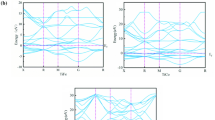Abstract
In this paper, a semi-analytical method was proposed to evaluate the acoustic nonlinearity parameter for single crystals of Cu, Ag and Au. The acoustic nonlinearity parameter can be derived analytically by general expressions in terms of the interatomic potentials with the distances between each pair of atoms in these transition metals. To evaluate the acoustic nonlinearity parameter, one needs to conduct one step molecular static simulation and obtain the equilibrium positions of all the atoms. Further, based on this method, numerical experiments with molecular dynamic code LAMMPS were given to compute the acoustic nonlinearity parameter of Cu, Ag and Au. To illustrate the validity of these expressions, comparison was made between calculation results and data in the literature. Reasonable agreement is observed. Because of the analytical nature of this method, it provides a fundamental understanding of the nonlinear elastic behavior of these transition metals.
Graphical Abstract
The second elastic constant and the third elastic constant can be computed with the proposed semi-analytical method. A reasonable agreement is found between the numerical calculations and the reported elastic constants for Cu, Ag and Au. The deviations might be due to the accuracy of the experimental processes and the microstructure factors like the grain structure, purity of the sample or the presence of impurities.

Similar content being viewed by others
References
Jhang KY. Nonlinear ultrasonic techniques for nondestructive assessment of micro damage in material: a review. Int J Precis Eng Manuf. 2009;10(1):123.
Qi HY, Shi H, Li SL, Yang XG. Fatigue crack growth of titanium alloy joints by electron beam welding. Rare Met. 2014;33(5):516.
Cantrell JH, Yost WT. Nonlinear ultrasonic characterization of fatigue microstructures. Int J Fatigue. 2001;23(1):487.
Nagy PB. Fatigue damage assessment by nonlinear ultrasonic materials characterization. Ultrasonics. 1998;36(1):375.
Stauffer JD, Woodward CB, White KR. Nonlinear ultrasonic testing with resonant and pulse velocity parameters for early damage in concrete. ACI Mater J. 2005;102(2):118.
Cobb A, Capps M, Duffer C, Feiger J, Robinson K, Hollingshaus B. Nonlinear ultrasonic measurements with EMATs for detecting pre-cracking fatigue damage. Rev Prog Quant Nondestr Eval. 2012;1430(1):299.
Jhang KY. Applications of nonlinear ultrasonics to the NDE of material degradation. IEEE Trans Ultrason Ferroelectr Freq Control. 2000;47(3):540.
Jhang KY, Kim KC. Evaluation of material degradation using nonlinear acoustic effect. Ultrasonics. 1999;37(1):39.
Sohn H, Lim HJ, DeSimio MP, Brown K, Derriso M. Nonlinear ultrasonic wave modulation for online fatigue crack detection. J Sound Vib. 2014;333(5):1473.
Hiki Y, Granato AV. Anharmonicity in noble metals; higher order elastic constants. Phys Rev. 1966;144(2):411.
Riley M, Skove M. Higher-order elastic constants of copper and nickel whiskers. Phys Rev B. 1973;8(2):466.
Powell B, Skove M. Measurement of higher-order elastic constants, using finite deformations. Phys Rev. 1968;174(3):977.
Lubarda VA. New estimates of the third-order elastic constants for isotropic aggregates of cubic crystals. J Mech Phys Solids. 1997;45(4):471.
Hamilton R, Parrott J. The third-order elastic constants of quasi-isotropic materials. J Phys C Solid State Phys. 1968;1(4):829.
Barsch GR. Relation between third-order elastic constants of single crystals and polycrystals. J Appl Phys. 1968;39(8):3780.
Srinivasan R. Lattice theory of third-order elastic constants of nonprimitive, nonpiezoelectric lattices. Phys Rev. 1966;144(2):620.
Martin J. Many-body forces in metals and the Brugger elastic constants. J Phys C Solid State Phys. 1975;8(18):2837.
Foiles S, Baskes M, Daw M. Embedded-atom-method functions for the fcc metals Cu, Ag, Au, Ni, Pd, Pt, and their alloys. Phys Rev B. 1986;33(12):7983.
Doyama M, Kogure Y. Embedded atom potentials in fcc and bcc metals. Comput Mater Sci. 1999;14(1):80.
Chantasiriwan S, Milstein F. Embedded-atom models of 12 cubic metals incorporating second and third order elastic-moduli data. Phys Rev B. 1998;58(10):5996.
Acknowledgments
This study was financially supported by the National Sci-Tech Support Plan (No. 2015BAF06B01).
Author information
Authors and Affiliations
Corresponding author
Rights and permissions
About this article
Cite this article
Chen, ZM., Zhang, Z. A semi-analytical method to compute acoustic nonlinearity parameter of Cu, Ag and Au. Rare Met. 42, 1050–1055 (2023). https://doi.org/10.1007/s12598-016-0738-z
Received:
Revised:
Accepted:
Published:
Issue Date:
DOI: https://doi.org/10.1007/s12598-016-0738-z



